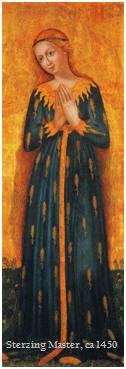Wheat Ears Dress
Wheat Ears Dress
Madonna In A Dress, Covered With Wheat Ears
— Sister M. Danielle Peters based on Marienlexikon I, 45f.

Our Lady clothed in a dark blue dress adorned with golden ears (see picture) is depicted as a youthful, standing Mary. Girded with a long knotted cincture, she is portrayed as a virgin whose hands are folded in prayer. Her long blonde hair touches her shoulders and often neck and wrists are surrounded by rays of light. Open hair, long loose robe and folded hands are the typical attributes of the temple virgin, especially when the figure is situated within a sanctuary type of building.
This image represents the Blessed Virgin as fertile soil and untilled field of God called to bear fruit, symbol for her virginal motherhood of God's Son. This image makes reference to the Eucharist: Mary can be seen as the tabernacle of God's Eucharistic presence. Another source may be the custom to shower newlyweds with ears, an expression of wishes for marital fertility. Another socio-cultural source for this rare iconographical motif may be found in Demeter whose attribute was the blade of wheat, symbol of fertility. Some authors have established a symbolic connection between Bethlehem, the "House of Bread" and Our Lady with the wheat ear covered dress. Patristic literature has applied the image of God's untilled soil bringing forth the fruit of all fruit to Our Lady and writings from the fifteenth century take recourse to it. The first portrayal of the Madonna in "ear dress" is a silver statue of Our Lady in Milan’s cathedral which dates back to 1387. This image was destroyed and replaced by a painting in 1465 which in turn was exchanged with a marble statue in 1485.
Several portrayals of the Madonna in "ear dress" from the fifteenth century are known. Among them are the image in Budweis, Czech Republic (St. Mary Church, 1410/20), Strassengel near Graz, Austria (ca 1435), Munich (National Museum, ca 1435) and the "Grain Mother" in Maria Ehrenburg, Pustertal, Germany. Many of these images bear an inscription pointing to the Madonna of Milan.
Earlier depictions of this type of Marian images combining virginity and motherhood show Our Lady in a flower garden sometimes with angels who, according to legend, brought her food when she was a temple virgin. Such paintings include an altar or some object reminiscent of Our Lady's stay in the temple (yarn) and of the Eucharist (bread and water). Often a wreath of flowers, symbol of Mary's virginity, is hung next to the image or is placed in the hands of the donor of the image kneeling before the Blessed Virgin. Among the most prominent depictions is A. Dürer's drawing of the Madonna of Ears in the prayer book of Emperor Maximilian I dated 1515.
In the sixteenth century some older images of Mary have been adorned with wheat ears. Veneration of the Madonna in the "ear dress" clearly declined during the Reformation; it was revived however in the context of the veneration of the Immaculate Conception in the seventeenth-eighteenth centuries. A second although less known trend of veneration of the Madonna in the "ear dress" started around 1600 with a panel of Wasserburg and ended approximately in 1770 with the painting of the Weizenährenfrau (woman with ears of wheat) by Maria Sorg of Salzburg. During the eighteenth century holy cards with the motive of the Madonna in the ear dress were spread widely. Occasionally she is also portrayed as the astrological sign of virgo holding ears in her hands.
All About Mary includes a variety of content, much of which reflects the expertise, interpretations and opinions of the individual authors and not necessarily of the Marian Library or the University of Dayton. Please share feedback or suggestions with marianlibrary@udayton.edu.
